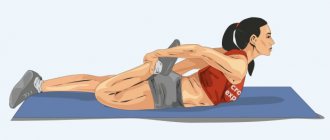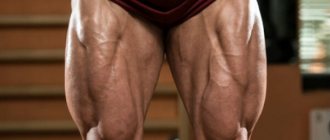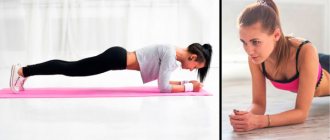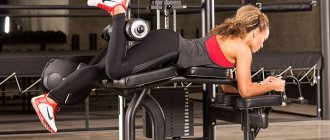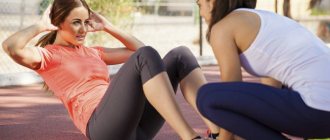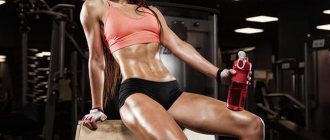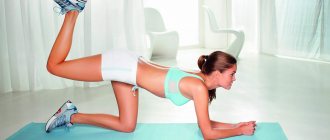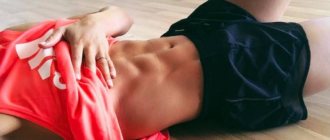What is Bosu and what is it for?
Bosu balance trainer is a hybrid of fitball and step platform. In such a simulator, a rubber inflatable hemispherical cushion or “bump” is attached to a solid plastic base.
Bosu - the abbreviation stands for Both Side Use, which means “two-sided”. The exercise machine is truly universal: it can be used as a complicated step platform, a balance beam, a fitball and a hand weight. The size of the device is small, 30 cm high and 65 cm in diameter, similar to half a ball. The elasticity of the inflatable part is regulated by a conventional pump. As additional accessories, you can attach expanders or handles to your boots.
This funny item was invented relatively recently - in 1999, by Marine and fitness trainer David Vack for a rehabilitation set of exercises. It quickly gained popularity around the world.
How to choose and where to buy a Bosu hemisphere?
In order to buy this simulator you need to know the following.
- The line of the most popular manufacturer of hemispheres in the USA called Bosu Balance Trainer and Bosu Balance Elite has a decent price from 139 to 180 dollars on the manufacturer’s website. May vary from store to store due to delivery price and trade markup. But there are many places where you can buy cheaper and with minimal loss of quality
- All simulators have the characteristics Length-Width-Height
- Some types of Bosu hemispheres are equipped with exercise handles
- Before you start choosing, you need to decide how often you will exercise. If it is very rare, then you need to buy the cheapest hemisphere. If often, then, of course, you need a high-quality and durable training tool
- You also need to decide on the following issues: will you carry it (different weights of different types of Bosu), what exercises will you do on it (buy with or without exercise machine handles), what weight is it designed for (so that your weight can withstand or your weight plus dumbbells), warranty (if it comes with a warranty, how long it lasts), durability (is it suitable for long-term use), size and thickness of plastic (diameter ranges from 33 to 70 cm), ease of maintenance (is it easy to clean and how easy is it to service)
- And, of course, you need to determine the amount you plan to spend on this simulator. You can buy it without much difficulty on Ozone or AliExpress
How does Bosu work?
Despite its apparent simplicity and “toy-like” appearance, the dome is able to engage deep muscles. Conventional aerobic exercises, complicated by balance and balance, affect muscle groups that home workout enthusiasts are not aware of.
Deep muscles are the basis of the skeleton and musculoskeletal system. They will never be visible from the outside, but it is these muscle connections that allow a person to move, hold the torso, head, and protect the spine from injury. They are responsible for blood supply, joint mobility, and stability of the nervous system.
The development of deep stabilizing muscles occurs only at the subconscious level, when a newborn child learns to hold his head, lean on his hands, sit, crawl, stand and walk. The basis for the involvement of deep stabilizing muscles is maintaining balance and mastering coordination, when tension in areas of muscle connections occurs unconsciously.
Benefits of classes
Training with Bosu is interesting and fun. Exercises can be performed standing, sitting, lying down. This is a great thing for improving the functioning of the vestibular apparatus of adults and children. The deep muscles are activated even without performing complex exercises. Learning to balance on a rubber dome and not fall is already excellent training in itself.
The Bosu balancing platform strengthens ligaments and tendons, promotes the restoration of joints after injuries, so Bosu can be found not only in fitness centers, but also in exercise therapy rooms and professional training facilities.
The hummock is perfect for girls and women who want to lose extra pounds without exhausting physical activity and pain. 5 minutes of barefoot balancing is equal to 5 minutes of jumping rope. On the Internet, in photos and videos, you can find a whole range of simple fat-burning barefoot exercises.
Bosu is a wonderful assistant for straightening posture with scoliosis, lidosis, giving joints gutta-percha, and all types of stretching. By the way, this is one of the few exercise machines that allows you to tighten the inner muscles of the thighs and buttocks without much effort.
The whole family can exercise on the hemisphere:
- The child will definitely enjoy jumping on the half-ball without disturbing the neighbors;
- the exercise machine will help mom maintain slimness and flexibility;
- Dad is able to use the platform for strength training.
The hummock is one of the few simulators for foot deformity, prevention and correction of flat feet in children and adults.
Training on Bosu: recommendations
- Do your workout only in sneakers that have a non-slip platform.
- Start small. Start doing the exercises after you have warmed up well. This could be a 15-minute warm-up on a treadmill or jumping on a hemisphere.
- If you have injured ligaments, perform the exercises under the strict guidance of an experienced trainer.
- If you decide to buy equipment for exercising at home, choose a mid-priced exercise machine. Cheap shells have a short service life.
- Don't overestimate your strength. Bosu exercises may seem ordinary at first. However, you should not grab dumbbells and other equipment. Do several approaches, then you will understand whether it is worth complicating the already difficult exercises.
Disadvantages and contraindications
Like any sports equipment, bosu has its own characteristics and contraindications. Exercises on the hemisphere are not recommended for:
- diseases of the respiratory and cardiovascular systems;
- violations of coordination and vestibular apparatus;
- being too overweight (more than 40% of body weight);
- acute injuries of joints, ligaments, spine;
- dizziness, sudden surges in blood pressure;
- prolapse of the kidneys;
- pregnancy.
Bosu has a couple of significant disadvantages - a large load on the ankles, which increases the risk of sprains, and high cost. However, the price is justified. By purchasing gymnastic equipment, you can get several effective and quite professional exercise equipment at once:
- Step platform.
- Fitball.
- Paraexpander
However, you do not need to purchase a platform to practice on Bosu. You can do exercises at the fitness club. In Moscow, such shells are available at La Salute.
Pros and cons of a balancing platform
The circular balance machine is designed to work several muscle groups simultaneously. The unstable, unstable platform is suitable for training both in the gym and at home. Its main purpose is to provide additional load on the body muscles responsible for maintaining balance and stabilizing the body when performing basic exercises. The Bosu platform has the following advantages and disadvantages:
Main advantages:
- Versatility. The Bosu hemisphere is suitable for Pilates, aerobic, rehabilitation exercises, stretching, and maintaining general health.
- The standard Bosu balance hemisphere is suitable for complicating any exercise. This effect is achieved by using the muscles responsible for maintaining balance.
- Training develops the core muscles, which strengthens the back and gives relief to the abdomen.
- Regular exercises using the hemisphere develop a sense of balance. This will help reduce falls and injuries in everyday life.
- The exercises you can do using the platform are varied. Most of the basic techniques can be adapted for Bosu.
- Availability. You can buy the platform at a low price.
- Safety. Training with a hemisphere has a low risk of injury.
- Self-training for exercises with a balancing platform does not last long. It's very easy to get used to.
Minuses:
- Lack of popularity of the simulator. For exercises using a projectile, it is difficult to find detailed instructions on the Internet.
- There are almost no exercises that develop the muscles of the lower legs.
- Exercises on a balancing platform are contraindicated for people with impaired coordination of movements or diseases affecting the vestibular apparatus.
- You cannot combine strength training with serious weights with classes on the Bosu hemisphere. It is not safe to maintain balance and perform exercises with heavy equipment at the same time. Take only light weights, dumbbells (up to 3 kg).
Who is the training suitable for?
Bosu fitness is perfect for beginners and the lazy. The loads can be increased gradually or you can get by with a minimal set of exercises – the effect will still be there. The equipment develops dexterity, flexibility, balance, so it will be a good preparation for skiing, skating, and snowboarding.
Russian hockey players and football players train on Bosu. While balancing on the dome, they perform soccer ball handling exercises.
For those who are struggling with those hated kilograms, the hemisphere will help avoid injuries to the spine and knees, smoothing out the shock loads on the joints. Traditional exercises, complicated by balancing, become many times more effective,
The fitness boss is shown to be busy and impatient, and someone who is tired of the usual routine workouts and wants to try something unusual and fun. With a boss you will have to relearn how to stand on one leg or squat.
The only thing more compact than a barefoot is a jump rope and dumbbells. The exercise machine can be deflated and placed on a shelf or under the sofa. In a small apartment, when you don’t want to clutter up the space with large trainer devices, but there is a need for full-fledged training.
Bosu balance trainer will be useful for those who have not yet decided on the direction of training or are interested in a little of everything - yoga, stretching, Pilates, aerobics, strength or cardio training.
An inflatable hummock is not suitable for those who are very heavy. According to the manufacturer's specifications, the load is limited to 150 kg.
What results to expect with regular training. Efficiency
After the first bosu classes, you will feel a feeling of muscle tone and fit. After six months of regular training, the joints will become mobile, muscle relief will appear, and endurance will increase.
Results of regular barefoot training:
- the simulator allows you to work out all the muscles without the use of additional equipment;
- Regular bosu classes help improve overall health, increase endurance, build a toned body and lose extra pounds;
- Coordination improves, balance develops, and stabilizer muscles are strengthened.
- the tone of all muscles increases significantly;
- Bosu classes eliminate high stress on the spine and joints. During exercises, the soft hemisphere reduces the level of injury;
- training is used during the rehabilitation period to recover from injury.
The bosu platform will help develop coordination and balance, as well as solve problems with the vestibular system. These skills are important both in everyday life and when performing exercises in other sports. There is no need to perform complex exercises. You can develop a sense of balance even just by standing on a platform.
Tips for Beginners
A few simple recommendations, more related to safety precautions when first approaching the projectile, will help you get pleasure from bosu and not injury. For exercises you need:
- Wear elastic clothing that fits tightly to the body, especially the ankles. While practicing on the canopy, it is easy to pinch the free edge of your pant leg or T-shirt and fall.
- Wear high-top sneakers that support the ankle. You can train barefoot, but it is advisable to have figure-eight bracelets with you.
- Even advanced athletes are recommended to start training on the canopy with the simplest exercises, gradually increasing the load.
- Before performing any tricks, you first need to learn how to balance confidently on it.
- Beginners, during their first training with bosu, should not forget that it can be unsafe without the supervision of an instructor.
For shy people, it’s better to start mastering Bosu in an individual lesson with a personal trainer. This will avoid awkward situations, since the first lesson is always accompanied by oddities and unusual movements. The instructors of the La Salute fitness club pay due sensitive attention to each client in order to avoid discomfort and injury when getting acquainted with the wonderful world of fitness.
What is this in fitness?
The rubber platform, made in the shape of a hemisphere, is an almost universal sports equipment. But what is it? The sphere with a rigid plastic base has a diameter of 65 cm and a height of approximately 30 cm. The degree of elasticity of the platform directly depends on the level of its air inflation. In fitness, bosu is used for strength and aerobic exercise, and the platform can also be used in Pilates and stretching (these are classes aimed at developing flexibility).
Basically, the convex side of the sphere is used for strength and aerobic exercises, and the flat side is used to develop coordination of the vestibular apparatus. Beginners are not recommended to start practicing using the flat side of the sphere, as this can be dangerous without additional training.
The bosu sports platform is often used by professional athletes to strengthen muscle tissue and increase endurance. © https://ydoo.info/qa/bosu-trenirovka.html Football players, tennis players, hockey players, basketball players and even gymnasts train with the help of the sphere. In addition, the equipment can be used as therapy to restore physical fitness after an injury.
The first classes on the platform are unusual, and sometimes seem impossible to beginners, but this is not the case. As with other sports equipment, performing bosu exercises requires practice and dexterity, which only comes with repeated practice.
A video about how beginners can properly handle bosu, how to maintain balance and where to start training can be watched below.
Types of training
Functional training is designed to maintain good physical shape and health and does not require any additional equipment, special clothing or a gym. They are based on our normal everyday movements, performed at an accelerated rhythm, with a certain sequence. But such exercises have one significant drawback - limitations. There comes a time when the body asks to increase and complicate the load.
Strength training is aimed at working out individual muscle groups; pumping occurs under the weight of your own body or with weights. They are needed to form relief and increase endurance. The downside is that the exercises are monotonous and tedious.
Functional training
Familiar and simple movements. When performed barefoot, the efficiency of the muscle ligaments increases significantly: superficial and deep, at the same time. Trainers joke: the bump allows you to put stress on your muscles, even if you just sit, stand or lie on it without doing any exercises.
Power training
The weight of the inflatable hummock is about 7 kilograms, so the simulator itself can be used as a weighting agent for strength exercises. It can be used to complicate all types of bench presses, squats, plyometrics, dynamic and static loads. The inflatable dome can withstand up to 150 kilograms, so it is suitable even for super heavyweight men.
The balancing platform allows you to perform all types of planks for effective core training.
How to do fitness correctly
To avoid various problems and benefit from training, you need to know and follow some rules/recommendations regarding training:
- Exercises on barefoot platforms should be performed only in shoes and these should be classic sneakers - non-slip soles, fixed heel. It is strictly not recommended to exercise on the exercise machine in question barefoot, wearing light sneakers.
- You need to start training with a warm-up and here it is important to learn how to balance on it. First you need to stand on the hemisphere with one foot, then with both, close your eyes and make sure that you managed to stand on the simulator. Without balancing skills, starting a workout is dangerous for your health, and there will be no effect. If, despite all the efforts made, you cannot balance, then it is worth reducing the level of inflation of the “dome”.
- You need to start your classes with an exercise from the aerobic training course - for example, use Bosa as a step to “climb”, jump on, and so on. Only after this complex is performed without tension and with confidence, will it be possible to move on to more complex loads - strength, cardio, and so on.
After Bosu fitness classes, the muscles continue to work for a long time even at rest. Beginners are recommended to conduct such training no more than 2 times a week.
Popular exercises
On the mound you can perform almost all dynamic and static training: from classic squats and lunges to super-burpees. For bosu, here are descriptions of the most common exercises and the features of their implementation.
Balancing
Mastering bossa starts with finding balance. Stand on a bump, place your feet closer to the center, parallel. Perform several movements with your arms, simple turns of the body, move your feet from heel to toe and back. If you don't fall, you can continue barefoot exercises for balance on one leg.
Lunges: classic, reverse, diagonal, side, Bulgarian (Romanian)
For beginners, the exercise mistakenly seems simple, but it belongs to an advanced level of training. For the effectiveness of lunges, the technique of execution, body positioning, different supports of the feet, and the angle of flexion of the legs are very important. Approximate diagram:
- Place your foot in the center of the bosu and try a classic forward lunge.
- Try to slowly transfer your body weight to the supporting leg and hold for at least a couple of seconds.
- Return to the starting position.
Working out the upper and lower abs, oblique abdominal muscles
The elastic surface of the bosu greatly reduces the load on the back when performing abdominal exercises and makes them more comfortable without losing effectiveness. Peculiarities:
- The buttocks should be positioned on the floor, the lower back resting on the dome, tangentially, at an angle of 450. You can complicate the exercise by resting your buttocks on the surface of the ball.
- Oblique twists should be performed with support on the bump of the hip joint, also at an angle of 450.
Raising and lowering the pelvis, gluteal bridge, planks
Exercises become more difficult due to the lack of a static point of support under the arms, legs or body. This is an intermediate and advanced level of loads.
Squats and squats
Performed with one or two feet resting on the dome. You cannot try to immediately do a deep squat with both legs resting on the sphere - you will definitely fall. You should start with squats, focusing on one foot. You can make it more difficult by turning the hummock upside down.
Hyperextension, push-ups
An effective advanced exercise for the back, buttocks, and legs. Scheme:
- Place your stomach or hands on your bare feet, and your toes on the floor.
- Place your body parallel to the floor, stretch your arms forward or point-blank.
- Slowly lift your shoulders and arms up. Listen to the sensations in your lower back.
Step-ups, jumping, burpee routine, weights
Can be performed if you are already confidently standing on the bosu ball without losing your balance. When working with dumbbells, it is better to use clamps. Even experienced athletes run the risk of dropping the equipment on themselves or on a training neighbor.
TOP 15 exercises on the bosu hemisphere
The optimal duration of a lesson on a hemisphere is 50-60 minutes. The training begins with simple basic exercises: alternately entering the platform with each foot, maintaining balance while standing barefoot. Gradually, the combinations become more difficult, and the training becomes more interesting.
We have collected the most effective bosu exercises that will pump up your entire body.
Exercise 1. Finding balance
Turn the bosu upside down so it's a hemisphere. Carefully enter the platform. And try to find balance. If the simulator is moderately inflated, this is not difficult to do. Shift your body weight from one leg to the other, getting used to the unstable position. Your task is to get to know the simulator.
Exercise 2. Warm up in a squat
The starting position of the simulator is the same. The feet are parallel on both sides of the platform. Squat down, moving your pelvis back, as if you were trying to sit on a chair. Find your balance. And start rolling, helping yourself with your hands.
Exercise 3. Squats on an inverted hemisphere
Without changing the starting position, actively and quickly begin squats. To warm up, it is enough to perform the movement 10-15 times, not forgetting to exhale as you rise. Experienced athletes can go even further and complete the set with several jumps, during which the feet barely leave the base of the Bosu.
Exercise 4. Jumping onto an inverted hemisphere
At the end of the warm-up, try to carefully jump onto the hemisphere and at the same time maintain balance. Don't straighten your legs, don't rush. Jump to the floor. And repeat the exercise 5-10 times.
Exercise 5. Plank with platform swing
After an active warm-up, we move on to the plank. The sphere is still installed base up. Lean against its edges with outstretched arms. Get into a plank position and begin to vigorously swing the platform from side to side. This movement uses all the back muscles.
Exercise 6. Rolling push-ups
The starting position is the same as in the previous exercise. Just now add push-ups. At the lowest point, exhale and roll four times from hand to hand. This exercise uses not only the abs and biceps, but also small intervertebral muscles.
Exercise 7. Climber
Starting position: rest on your toes and palms, which still stand on your inverted barefoot. The stomach is pulled in, the back is straight. As you exhale, pull your knee toward your chest, and as you inhale, return to the starting position. Repeat with the other leg. Perform at a fast pace for 1-2 minutes. The exercise is very popular among American fitness trainers, who believe that the “Mountaineer” works the abdominal muscles much more effectively than crunches and glute bridges.
Exercise 8. Lying emphasis, step forward
The starting position is the same as in the previous exercise. But now alternately take a wide step with one or the other foot. Place your foot to the side of the machine. The exercise provides a load to the abdominal muscles and works the inner thighs.
Exercise 9. Squats on one leg
The simulator is installed with the base up. Step on it with one foot, catch your balance. Then slowly and smoothly pull your knee up to your chest and then move your leg back. Repeat 5-10 times for each leg. The exercise effectively works the abs, outer and front thighs.
Exercise 10. Stepping to the side
Place the bosu with the sphere facing up. Spread your legs as wide as possible. Place one foot on the machine, the other firmly on the floor. Push off the floor sharply, jump over your barefoot so that your other leg is now on the hemisphere. Jump energetically and high, accompanying each jump with an exhalation.
Exercise 11. Step-up across the platform + 180 turn
A more complex variation of the previous exercise. The stretcher qualitatively pumps the adductor muscles of the thighs, quadriceps and gluteus maximus muscles. And it is one of the most effective exercises for the legs and buttocks.
Exercise 12. Squat with barefoot jumping
Place your feet on either side of the sphere. Squat down, touching your palms to the middle of the machine. Inhale and jump onto your barefoot with both feet. Jump back to the starting position. Repeat 5-10 times. The exercise pumps up the inner and outer thighs, strengthens the legs, and develops endurance.
Exercise 13. Hard pumping of the press
Sit on top of your barefoot so that you can fully straighten your legs without them touching the floor. Move your body back, fix the position in a reclining position. And start performing V-shaped crunches at a fast pace. The instability of the position forces all the core muscles to engage in work, and the abs will begin to burn after 10-15 repetitions.
Exercise 14. Pumping the abs with emphasis on one leg
We engage the oblique abdominal muscles. Sit on the barefoot. Bend one leg at the knee and place it on the floor. Pull the second one up. Lean back slightly. And begin performing V-shaped twists, trying to reach the toe of your outstretched leg with both hands. Repeat 10-15 times on each leg.
Exercise 15. Lifting the pelvis while lying on your back
Lie on your back, place both feet on your bare feet and begin, as you exhale, to lift your pelvis up, focusing on your feet. Repeat 10-15 times. And then the same amount, but lingering at the top point for 3-4 seconds.
Thanks to the following YouTube channels for the GIF: Sapinsky Training, Сoach Club - training for fitness trainers, Karen O'Connell.
Reviews
Alexa: “I’ve known about Bosu for a long time, but I decided to try it a couple of months ago. Fitball didn’t suit me; it was just scary to practice. The first few weeks after functional training, I did 2-3 approaches to the barefoot, learning not to slip off it. After another couple of weeks I was able to squat. What can I say – great! My dreams of perfect hips and buttocks came true, although before that I had been doing fitness for four years.”
Vladimir: “A great thing for skiers and snowboarders to stay in shape. Ski simulators are a bit expensive, and there’s not much room to put one in an apartment. The bump saved us during quarantine, when it was neither possible to go out nor to train in the gym.”
Marina: “I’m not a sports fan at all, I was. A friend dragged me to class and promised that it wouldn’t be boring. At the first training sessions, it was really fun, we played around more than exercised. Moreover, I was not tired at all, although my butt and stomach ached. Somehow, unbeknownst to myself, I got involved. Thanks to my boss, coach and friend. Now I go to the gym with pleasure.”
